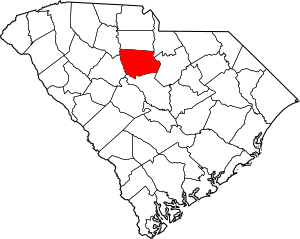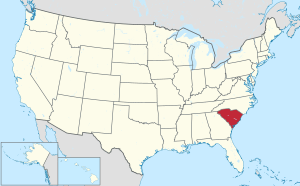Fairfield County, South Carolina facts for kids
Quick facts for kids
Fairfield County
|
||
|---|---|---|

Fairfield County Courthouse
|
||
|
||
| Motto(s):
"Capital Convenience, Country Comfort"
|
||

Location within the U.S. state of South Carolina
|
||
 South Carolina's location within the U.S. |
||
| Country | ||
| State | ||
| Founded | 1785 | |
| Named for | Comment made by General Cornwallis stating ""How Fair These Fields" | |
| Seat | Winnsboro | |
| Largest community | Winnsboro | |
| Area | ||
| • Total | 709.87 sq mi (1,838.6 km2) | |
| • Land | 686.31 sq mi (1,777.5 km2) | |
| • Water | 23.56 sq mi (61.0 km2) 3.32% | |
| Population
(2020)
|
||
| • Total | 20,948 | |
| • Estimate
(2023)
|
20,422 | |
| • Density | 30.52/sq mi (11.78/km2) | |
| Time zone | UTC−5 (Eastern) | |
| • Summer (DST) | UTC−4 (EDT) | |
| Congressional district | 5th | |
Fairfield County is a special area in South Carolina, a state in the United States. It's called a county. In 2020, about 20,948 people lived here. The main town, or county seat, is Winnsboro.
Fairfield County is also part of the larger Columbia, SC area.
Contents
Exploring Fairfield County's Past
How Did Fairfield County Get Its Name?
The name "Fairfield" might have come from a famous British general, General Cornwallis. During the American Revolutionary War (around 1780-1781), he was in the area. It's said he looked around and declared, "How Fair These Fields!" The house where he stayed is still standing today.
Early Settlers and Winnsboro's Beginnings
Before the Revolutionary War, a man named Richard Winn moved to this area from Virginia. His land became the town of Winnsboro. By 1777, people already called the settlement "Winnsborough."
In 1785, Richard Winn and others helped officially create the village. Richard Winn was a general in the Revolutionary War. He fought in many battles for South Carolina.
Historic Churches and Their Stories
Fairfield County has many old churches. Some have been around for over 200 years! One very famous church is the Old Brick Church, built in 1788.
During the American Civil War, General Sherman's troops used the church's floorboards. They needed them to build a crossing over a nearby river. A note on the wall shows a Union soldier felt bad about this.
Cotton and Changes in the 1800s
In the mid-1700s, early settlers brought cotton farming to the county. Enslaved African Americans were forced to do the hard work of growing this crop.
Later, the invention of the cotton gin made it easier to grow cotton. Cotton became the main crop in Fairfield County from the early 1800s until the 1920s. After the Civil War, many African Americans who had been enslaved became sharecroppers or tenant farmers.
Over time, the soil became tired. Also, tiny bugs called boll weevils damaged the cotton plants. New machines meant fewer people were needed for farm work. Because of this, many African Americans moved away. This big move, called the Great Migration, happened in the first half of the 1900s. They went to cities in the North and Midwest for new jobs and to escape unfair rules.
Winnsboro's Town Clock and Courthouse
In 1832, Winnsboro officially became a town. The most famous building in Winnsboro is the Town Clock. It was built as a market house. A clock was added in 1837.
The County Courthouse is across from the Town Clock. It was built in 1823. A famous South Carolina architect, Robert Mills, designed it. This courthouse holds important records from the mid-1700s.
Reconstruction Era in Fairfield County
After the Civil War, during a time called Reconstruction, Fairfield District became Fairfield County. Union soldiers were stationed there. In 1868, people who had fought for the Confederacy could not vote. This meant most voters in Fairfield County were African American.
In 1868, an African American man named George Barber was elected to the South Carolina State Senate. Two African American men, Henry Jacob and Henry Johnson, were also elected to the state House of Representatives. This was a huge change! Even with lots of spending, Fairfield County was one of only two counties not in debt by 1870. In 1872, U.S. troops were in the county to stop groups like the Ku Klux Klan from causing trouble during voting.
Fairfield County also has large granite deposits. This led to quarrying, which is digging up stone. "Winnsboro blue granite" is famous and used in buildings around the world.
Fairfield County in the 1900s
In the 1960s, the county was home to the Carolinas–Virginia Tube Reactor. In 1984, the Virgil C. Summer Nuclear Generating Station was built here. The Fairfield County Airport opened in 1975. A gold mine, the Ridgeway Mine, operated near Ridgeway from 1988 to 1999.
Fairfield County's Geography
Fairfield County covers about 710 square miles. Most of this is land, with about 24 square miles of water.
The Sumter National Forest has a part in Fairfield County. It's a great place for outdoor fun. The county is also known for its many deer and wild turkeys, which makes it popular for hunting. You can also visit Lake Wateree State Recreation Area.
Protected Natural Areas
- Sumter National Forest (part)
Local Parks and Sites
- Lake Monticello Park
- Lake Wateree State Park
- Monticello Recreational Lake Beach
- The South Carolina Railroad Museum
- Upland Wings Preserve
Important Rivers and Lakes
- Big Cedar Creek
- Broad River
- Catawba River
- Great Falls Lake
- Lake Wateree
- Little River
- Monticello Reservoir
- Persimmon Creek
Neighboring Counties
Fairfield County shares borders with these other counties:
- Chester County – to the north
- Lancaster County – to the northeast
- Kershaw County – to the east
- Richland County – to the south
- Newberry County – to the southwest
- Union County – to the northwest
Main Roads in Fairfield County
Several important highways run through Fairfield County:
 I-77
I-77 US 21
US 21 US 321
US 321 SC 34
SC 34 SC 200
SC 200 SC 213
SC 213 SC 215
SC 215 SC 269
SC 269 SC 901
SC 901
Key Transportation Hubs
- Fairfield County Airport
Fairfield County's Population
The number of people living in Fairfield County has changed over time. In 1790, there were 7,623 people. By 2020, the population was 20,948.
Who Lives in Fairfield County?
In 2020, there were 20,948 people living in Fairfield County. About 53.47% of the people were Black or African American. About 40.59% were White. Other groups included Native American, Asian, Pacific Islander, and people of mixed races. About 2.02% of the population was Hispanic or Latino.
In 2010, there were 23,956 people. The average household had 2.50 people. The average family had 3.01 people. The average age of people in the county was 42.4 years old.
Fairfield County's Economy
In 2022, the total value of all goods and services produced in Fairfield County was about $1.4 billion. This is a way to measure how much money the county's economy makes.
Some of the biggest employers in Fairfield County include:
- BOMAG (a company that makes heavy equipment)
- Dominion Energy (an energy company)
- Element Electronics (an electronics company)
- Food Lion (a grocery store chain)
- The town of Winnsboro
- Universal Protection Service (a security company)
Poverty in Fairfield County
In 2018, the average household income in Fairfield County was lower than the state average for South Carolina. About 23% of the county's residents lived in poverty. For children, the rate was higher, with about 32% of children living in poverty.
Communities in Fairfield County
Towns
- Blythewood (mostly in a neighboring county)
- Jenkinsville
- Ridgeway
- Winnsboro (This is the county seat and the largest town.)
Census-Designated Place
Smaller Communities (Unincorporated)
These are smaller areas that are not officially towns:
- Adger
- Blackjack
- Blackstock
- Blair
- Bucklick
- Feasterville
- Longtown
- Mitford
- Monticello
- Rion
Images for kids
See also
 In Spanish: Condado de Fairfield (Carolina del Sur) para niños
In Spanish: Condado de Fairfield (Carolina del Sur) para niños



